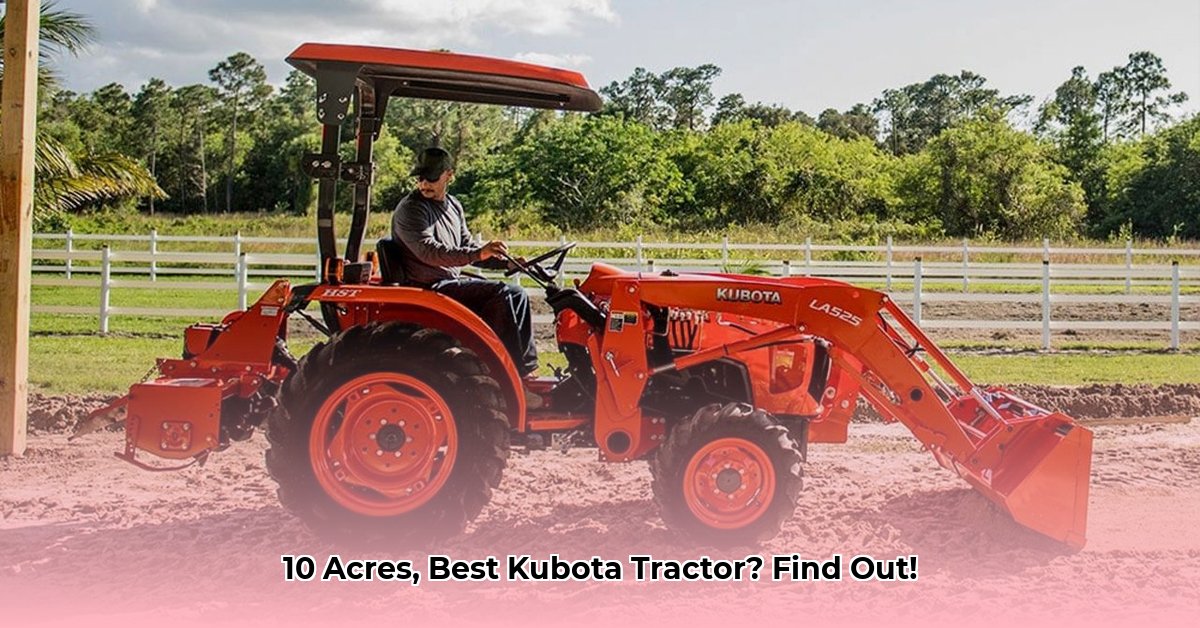
Choosing the right tractor for your 10-acre farm is a crucial decision impacting efficiency, sustainability, and your bottom line. This guide provides a step-by-step process to select the ideal Kubota tractor (or a comparable alternative) tailored to your specific needs and budget. For more information on Kubota packages, check out this resource.
Assessing Your Farm's Needs: A Personalized Checklist
Before exploring tractor models, thoroughly assess your farm's requirements. This involves a detailed analysis of several key factors:
Tasks and Operations: What are your primary farming activities? Hay production? Orchard management? General land maintenance? This dictates the necessary horsepower and attachments. For example, extensive tillage requires more power than simple mowing.
Terrain Analysis: Carefully map your land. Flat fields need less powerful tractors than hilly or rocky terrains. Steep slopes demand 4-wheel drive (4WD) for better traction and safety. Narrow spaces might necessitate a highly maneuverable compact tractor.
Budgetary Constraints: New tractors are a substantial investment. Establish a realistic budget encompassing not only the purchase price but also ongoing maintenance, fuel, and potential repairs. Exploring financing options and considering used tractors can significantly impact affordability.
Sustainability Goals: Environmental considerations are increasingly important. Prioritize fuel-efficient models to lower your carbon footprint and operating costs. Explore precision farming technologies to optimize resource use.
This comprehensive assessment will guide you towards suitable tractor options based on your specific requirements.
Understanding Tractor Types and Horsepower: The Power Equation
Tractor types significantly impact their capabilities and suitability for diverse tasks. For 10-acre farms, compact utility tractors (CUTs) often represent the best balance of power and maneuverability. However, understanding the different classes is vital:
| Tractor Type | Typical Horsepower Range | Ideal Applications | Considerations |
|---|---|---|---|
| Sub-Compact | Under 25 HP | Small yards, light-duty tasks | Limited capabilities; may struggle with heavier workloads |
| Compact Utility (CUT) | 25-50 HP | Most 10-acre farm tasks; versatile and efficient | A good balance of power and agility |
| Utility | Over 50 HP | Larger acreage, demanding tasks; significant power | Less maneuverable on smaller properties; higher cost |
For a 10-acre farm, a CUT typically offers the optimal combination of power and maneuverability for various tasks. However, your specific needs might lean towards a sub-compact for lighter chores or a utility tractor for demanding operations on level terrain.
Choosing the Right Kubota Model (and its Alternatives): Brand Comparison
Kubota is a reputable manufacturer known for its reliable tractors. However, the “best” tractor depends on your farm’s unique requirements, not solely the brand. Several Kubota CUT models are popular choices:
Kubota BX Series: Ideal for smaller properties and demanding maneuverability.
Kubota L Series: Offers higher horsepower for heavier tasks like tilling or using larger attachments.
Kubota B Series: A robust option suitable for a wide range of applications.
Remember, other manufacturers (John Deere, Mahindra, etc.) offer competitive CUTs. Thorough research across brands is crucial to identify the tractor that best matches your specifications and budget. Don't limit yourself to a single brand; explore all options. Have you considered the fuel efficiency of the options you are evaluating?
Essential Features and Considerations: Beyond Horsepower and Brand
Beyond horsepower and brand, several crucial features define a tractor's suitability:
Fuel Efficiency: Prioritize models with features promoting fuel economy. This reduces running costs and minimizes your carbon footprint.
Attachment Compatibility: Identify the implements you'll need (mowers, loaders, tillers). Ensure the tractor's three-point hitch and hydraulic system align with your chosen attachments.
Safety Features: Safety is paramount. Look for Roll Over Protective Structures (ROPS), seatbelts, and clear visibility features.
Ease of Maintenance: Simple maintenance procedures and readily accessible components reduce downtime and long-term costs.
Sustainability in Action: Farming for Tomorrow
Sustainable farming practices are vital. Consider integrating:
Precision Farming: GPS guidance and variable-rate technology optimize resource use, reducing fuel consumption and minimizing environmental impact.
Alternative Fuels: While still emerging, keep an eye on the development of electric or hybrid tractors, offering a path towards more sustainable agricultural practices.
Budgeting and Financing: Planning Your Investment
Tractor prices vary widely. Create a detailed budget including the purchase price, attachments, maintenance, and potential repairs. Explore financing options from dealerships or lenders to manage the costs effectively. Remember that purchasing a used, well-maintained tractor can considerably reduce upfront expenses.
Maintenance and Long-Term Planning: Investing in Longevity
Regular maintenance extends the tractor's life and optimizes fuel efficiency. Adhere to the manufacturer's recommended service schedule for oil changes, filter replacements, and component inspections. Planned preventative maintenance minimizes costly repairs down the line. Budget for potential repairs and upgrades to ensure continued optimal performance.
Conclusion: Finding Your Perfect Farming Partner
Selecting the right tractor is a significant investment. By carefully assessing your needs and comparing various options, you can find the perfect tractor for your 10-acre farm, maximizing efficiency and sustainability. And remember, consulting with local agricultural experts can provide invaluable personalized advice.